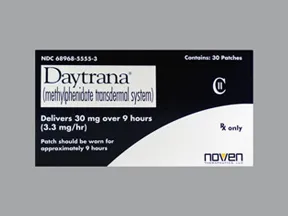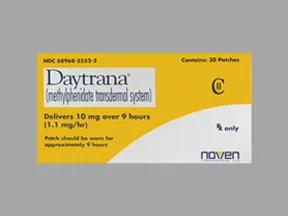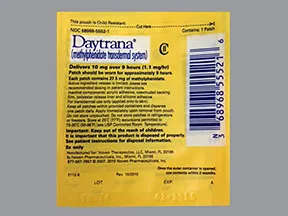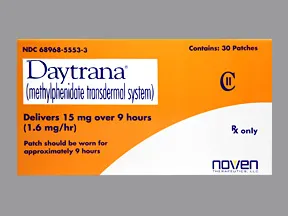Uses
This medication is used to treat attention deficit hyperactivity disorder - ADHD. It works by changing the amounts of certain natural substances in the brain. Methylphenidate belongs to a class of drugs known as stimulants. It can help increase your ability to pay attention, stay focused on an activity, and control behavior problems. It may also help you to organize your tasks and improve listening skills.
How to use Daytrana Patch, Transdermal 24 Hours
Read the Medication Guide provided by your pharmacist before you start using methylphenidate and each time you get a refill. Read and follow all directions in the Instructions for Use. Learn how to properly use, store, and discard the patches. If you have any questions, ask your doctor or pharmacist.
Apply this medication to the skin as directed by your doctor, usually once daily in the morning, 2 hours before you need the effects of this drug. Then remove the patch as directed by your doctor, usually 9 hours later. Applying this medication late in the day may cause trouble sleeping (insomnia). If you apply this patch in the early morning and still have trouble sleeping, your doctor may direct you to remove the patch within less than 9 hours. Carefully follow your doctor's instructions.
This medication should be applied to a clean, dry area of skin on the hip. Before applying the patch, gently wash, rinse, and dry the application area. Do not apply to cut or irritated skin. Remove the patch from the pouch and apply right away as directed. Do not cut the patch. When using a new patch the next day, apply to an area of skin on the other hip to avoid irritation. Do not apply a heating pad or other heat to the patch area since this may increase the risk of side effects. Bathing, swimming, or showering may affect how well the patch stays on the skin. If the patch does not stick properly or falls off, replace with a new patch at another site. Remove the new patch at your usual time, usually 9 hours after applying the first patch.
After removing the patch, fold it in half with the sticky sides together and throw it away as directed. Do not touch the sticky side with your fingers. Wash your hands after applying or removing the patch.
Use this medication regularly to get the most benefit from it. To help you remember, use it at the same time each day.
The dosage is based on your medical condition and response to treatment. Your doctor may direct you to gradually increase or decrease your dose. Also, if you have used it for a long time, do not suddenly stop using this drug without consulting your doctor.
If you suddenly stop using this medication, you may have withdrawal symptoms (such as depression, suicidal thoughts, or other mental/mood changes). To help prevent withdrawal, your doctor may lower your dose slowly. Withdrawal is more likely if you have used methylphenidate for a long time or in high doses. Tell your doctor or pharmacist right away if you have withdrawal.
When used for a long time, this medication may not work as well. Talk with your doctor if this medication stops working well.
Though it helps many people, this medication may sometimes cause addiction. This risk may be higher if you have a substance use disorder (such as overuse of or addiction to drugs/alcohol). Use this medication exactly as prescribed to lower the risk of addiction. Ask your doctor or pharmacist for more details.
Tell your doctor if your condition does not improve or if it worsens.
Side Effects
Nervousness, trouble sleeping, loss of appetite, weight loss, dizziness, nausea, vomiting, or headache may occur. Mild irritation or redness at the application site may also occur. If any of these effects last or get worse, tell your doctor or pharmacist promptly.
Remember that this medication has been prescribed because your doctor has judged that the benefit to you is greater than the risk of side effects. Many people using this medication do not have serious side effects.
This medication may raise your blood pressure. Check your blood pressure regularly and tell your doctor if the results are high.
Tell your doctor right away if you have any serious side effects, including: signs of blood flow problems in the fingers or toes (such as coldness, numbness, pain, or skin color changes), unusual wounds on the fingers or toes, fast/pounding/irregular heartbeat, mental/mood/behavior changes (such as agitation, aggression, mood swings, abnormal thoughts, thoughts of suicide), uncontrolled muscle movements (such as twitching, shaking), sudden outbursts of words/sounds that are hard to control, vision changes (such as blurred vision), slow healing sores/ulcers on the tips of fingers/toes.
Get medical help right away if you have any very serious side effects, including: fainting, seizure, symptoms of a heart attack (such as chest/jaw/left arm pain, shortness of breath, unusual sweating), symptoms of a stroke (such as weakness on one side of the body, trouble speaking, sudden vision changes, confusion).
Rarely, males (including young boys and teens) may have a painful or prolonged erection lasting 4 or more hours while using this medication. Caregivers/parents should also be watchful for this serious side effect in boys. If a painful or prolonged erection occurs, stop using this drug and get medical help right away, or permanent problems could occur. Ask your doctor or pharmacist for more details.
This patch may cause the skin under it to lighten (whiten) in color. This may sometimes occur even on skin that was never covered by this patch. The lightened skin color may be permanent, so tell your doctor right away if you notice any skin color changes.
A very serious allergic reaction to this drug is rare. However, get medical help right away if you notice any symptoms of a serious allergic reaction, including: rash, itching/swelling (especially of the face/tongue/throat), severe dizziness, trouble breathing.
This is not a complete list of possible side effects. If you notice other effects not listed above, contact your doctor or pharmacist.
In the US -
Call your doctor for medical advice about side effects. You may report side effects to FDA at 1-800-FDA-1088 or at www.fda.gov/medwatch.
In Canada - Call your doctor for medical advice about side effects. You may report side effects to Health Canada at 1-866-234-2345.
Warnings
Misuse or abuse of methylphenidate can result in serious (possibly fatal) heart and blood pressure problems.
This medication can be habit-forming and should be used cautiously by people who have mental/mood disorders or a substance use disorder (such as overuse of or addiction to drugs/alcohol). Before using this medication, tell your doctor if you have a personal or family history of a substance use disorder. Do not increase your dose, use it more often, or use it for a longer time or in a different way than prescribed. Doing so may result in a decrease in the effect of this drug, drug dependence, or abnormal thoughts/behavior.
Your doctor may monitor you for a while after the medication is stopped, especially if you have used this drug for a long time or in high doses. (See also How to Use section.
Precautions
See also Warning section.
Before using methylphenidate, tell your doctor or pharmacist if you are allergic to it; or to dexmethylphenidate; or if you have any other allergies. This product may contain inactive ingredients, which can cause allergic reactions or other problems. Talk to your pharmacist for more details.
Before using this medication, tell your doctor or pharmacist your medical history, especially of: high blood pressure, blood circulation problems (such as Raynaud's disease), glaucoma, heart problems (such as irregular heartbeat, heart failure, previous heart attack, problems with heart structure), family history of heart problems (such as sudden cardiac death, irregular heartbeat), mental/mood conditions (especially anxiety, tension, agitation), personal/family history of mental/mood disorders (such as bipolar disorder, depression, psychosis, suicidal thoughts), personal/family history of uncontrolled muscle movements (motor tics, Tourette's syndrome), personal/family history of a certain skin condition (vitiligo), overactive thyroid (hyperthyroidism), seizure disorder.
This drug may make you dizzy. Alcohol or marijuana (cannabis) can make you more dizzy. Do not drive, use machinery, or do anything that needs alertness until you can do it safely. Limit alcoholic beverages. Talk to your doctor if you are using marijuana (cannabis).
If you are going to have an MRI test, tell testing personnel that you are using this patch. Some patches may contain metals that can cause serious burns during an MRI. Ask your doctor whether you will need to remove your patch before the test and apply a new patch afterward, and how to do so properly.
Before having surgery, tell your doctor or dentist about all the products you use (including prescription drugs, nonprescription drugs, and herbal products).
If used for a long time, this drug may affect a child's growth rate, weight, and final adult height. To reduce the risk, the doctor may recommend briefly stopping the medication from time to time. Check the child's weight and height regularly, and consult your doctor or pharmacist for more details.
Older adults may be more sensitive to the side effects of this drug, especially trouble sleeping, weight loss, or chest pain.
During pregnancy, methylphenidate should be used only when clearly needed. Discuss the risks and benefits with your doctor.
This medication passes into breast milk. Consult your doctor before breastfeeding.
Interactions
Drug interactions may change how your medications work or increase your risk for serious side effects. This document does not contain all possible drug interactions. Keep a list of all the products you use (including prescription/nonprescription drugs and herbal products) and share it with your doctor and pharmacist. Do not start, stop, or change the dosage of any medicines without your doctor's approval.
Taking MAO inhibitors with this medication may cause a serious (possibly fatal) drug interaction. Avoid taking MAO inhibitors (isocarboxazid, linezolid, metaxalone, methylene blue, moclobemide, phenelzine, procarbazine, rasagiline, safinamide, selegiline, tranylcypromine) during treatment with this medication. Most MAO inhibitors should also not be taken for two weeks before treatment with this medication. Ask your doctor when to start or stop taking this medication.
Methylphenidate is very similar to dexmethylphenidate. Do not use medications containing dexmethylphenidate while using methylphenidate.
This medication may interfere with certain medical/lab tests (such as brain scan for Parkinson's disease), possibly causing false test results. Make sure lab personnel and all your doctors know you use this drug.
Overdose
This medication patch may be harmful if chewed or swallowed. If someone has overdosed, remove the patch if possible. For serious symptoms such as passing out or trouble breathing, call 911. Otherwise, call a poison control center right away. US residents can call 1-800-222-1222. Canada residents can call 1-844-764-7669. Symptoms of overdose may include: vomiting, agitation, confusion, sweating, flushing, muscle twitching, hallucinations, seizures, loss of consciousness.
Do not share this medication with others. Sharing it is against the law.
Lab and/or medical tests (such as blood pressure, complete blood count, height/weight monitoring in children) may be done while you are using this medication. Keep all medical and lab appointments. Consult your doctor for more details.
If switching from another form of methylphenidate to this patch, carefully follow your doctor's instructions.
If you miss a dose, use it as soon as you remember. If it is near bedtime or near the time of the next dose, skip the missed dose. Use your next dose at the regular time. Do not double the dose to catch up.
This medication comes in a sealed tray or outer pouch. After opening the sealed tray/outer pouch, use/discard patches within 2 months.
Store the individual protective pouches at room temperature away from light and moisture. Do not refrigerate or freeze. Do not store in the bathroom. Keep all medications away from children and pets.
Do not flush medications down the toilet or pour them into a drain unless instructed to do so. Properly discard this product when it is expired or no longer needed (see also How to Use section). For more details, read the Instructions for Use, or consult your pharmacist or local waste disposal company.
Images

Daytrana 20 mg/9 hr daily patch
Color: Shape: Imprint:This medicine is a transdermal system

Daytrana 30 mg/9 hr daily patch
Color: Shape: Imprint:This medicine is a transdermal system

Daytrana 10 mg/9 hr daily patch
Color: Shape: Imprint:This medicine is a transdermal system

Daytrana 10 mg/9 hr daily patch
Color: Shape: Imprint:This medicine is a transdermal system

Daytrana 15 mg/9 hr daily patch
Color: Shape: Imprint:This medicine is a transdermal system
You Might Also Like
Are you currently using Daytrana Patch, Transdermal 24 Hours?
This survey is being conducted by the WebMD marketing sciences department.
Selected from data included with permission and copyrighted by First Databank, Inc. This copyrighted material has been downloaded from a licensed data provider and is not for distribution, except as may be authorized by the applicable terms of use.
CONDITIONS OF USE: The information in this database is intended to supplement, not substitute for, the expertise and judgment of healthcare professionals. The information is not intended to cover all possible uses, directions, precautions, drug interactions or adverse effects, nor should it be construed to indicate that use of a particular drug is safe, appropriate or effective for you or anyone else. A healthcare professional should be consulted before taking any drug, changing any diet or commencing or discontinuing any course of treatment.